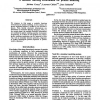94
Voted
BMCBI
2010
15 years 24 days ago
2010
Background: Protein loops encompass 50% of protein residues in available three-dimensional structures. These regions are often involved in protein functions, e.g. binding site, ca...
113
Voted
BIOINFORMATICS
2007
15 years 24 days ago
2007
: Large amounts of protein and domain interaction data are being produced by experimental high-throughput techniques and computational approaches. To gain insight into the value of...
86
Voted
BIB
2007
15 years 24 days ago
2007
Protein function is a dynamic property closely related to the conformational mechanisms of protein structure in its physiological environment. To understand and control the functi...
88
Voted
AROBOTS
2007
15 years 25 days ago
2007
The process of protein crystallization is explained using the theory of robotics, particularly path planning of mobile robots. Path planning is a procedure which specifies motion ...
136
click to vote
BIBE
2007
IEEE
15 years 26 days ago
2007
IEEE
While much research has been done on finding similarities between protein sequences, there has not been the same progress on finding similarities between protein structures. Here ...
114
Voted
HPDC
2010
IEEE
15 years 1 months ago
2010
IEEE
A common task in biological research is to predict function for proteins by comparing sequences between proteins of known and unknown function. This is often done using pair-wise ...
ISMB
1993
15 years 2 months ago
1993
Wepropose in this paper a modularlearning environmentfor proteinmodeling.In this system,the protein modelingproblemis tackledin twosuccessive phases. First, partial structural inf...
106
Voted
ISMB
1994
15 years 2 months ago
1994
In this paper, westudy the application of an ttMM(hidden Markov model) to the problem of representing protein sequencesby a stochastic motif. Astochastic protein motif represents ...
ISMB
1997
15 years 2 months ago
1997
The structural comparison of proteins has become increasingly important as a means to identify protein motifs and fold families. In this paper we present a new algorithm for the c...
114
Voted
ISMB
2000
15 years 2 months ago
2000
Determination of the functions of all expressed proteins represents one of the major upcoming challenges in computational molecular biology. Since subcellular location plays a cru...



